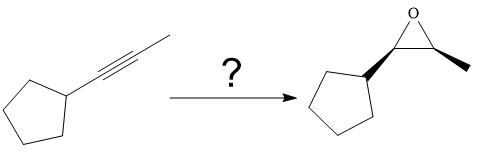
(a)
Interpretation:
How to synthesize a given compound from
Concept introduction:
Answer to Problem 25.76P
The synthesis of a given compound from

Explanation of Solution
The given synthesis is

The direct conversion is not known. Therefore, the retrosynthesis analysis is done to know the possible route for the synthesis. It is noticed that the cyclopentyl ring and methyl group are trans to each other, thus the alkene results from

Thus the forward reaction is carried out as below:

Since the cyclopentyl ring and methyl group are trans to each other, the alkene results from
It is shown how to synthesize a given compound from
(b)
Interpretation:
It is to be shown how to synthesize a given compound from
Concept introduction:
Alkynes can be converted to the corresponding alkene either by the treatment of alkali metal (e.g. Na, K) in ammonia or by catalytic hydrogenation. The advantage of the catalytic hydrogenation is to form the cis-alkene by the syn-addition of molecular hydrogen,
Answer to Problem 25.76P
The synthesis of the given compound from

Explanation of Solution
The given synthesis is

The direct conversion is not known. Therefore, the retrosynthesis analysis is done to know the possible route for the synthesis. It is noticed that the cyclopentyl ring and methyl group are cis to each other, thus the alkene results from

Thus the forward reaction is carried out as below:

Since the cyclopentyl ring and methyl group are cis to each other, the alkene results from
It is shown how to synthesize a given compound from
(c)
Interpretation:
It is to be shown how to synthesize a given compound from
Concept introduction:
Alkynes can be converted to the corresponding alkene either by the treatment of alkali metal (e.g. Na, K) in ammonia called a dissolving metal reduction or by catalytic hydrogenation. The advantage of the catalytic hydrogenation is to form the cis-alkene by the syn-addition of molecular hydrogen,
Answer to Problem 25.76P
The synthesis of the given compound from

Explanation of Solution
The given synthesis is

The direct conversion is not known. Therefore, the retrosynthesis analysis is done to know the possible route for the synthesis.

The forward reaction is carried out as:
In the first step the reduction of the alkyne is done to the corresponding alkane by the catalytic hydrogenation as follows:

Finally, the proton of the tertiary carbon is replaced by bromine atom by the treatment of molecular bromine in the presence of light. The tertiary carbon is brominated via a free radical mechanism to form the required product.

It is to be shown how to synthesize a given compound from
(d)
Interpretation:
How to synthesize a given compound from
Concept introduction:
Alkynes can be converted to the corresponding alkene either by the treatment of alkali metal (e.g. Na, K) in ammonia called a dissolving metal reduction or by catalytic hydrogenation. The advantage of the catalytic hydrogenation is to form the cis-alkene by the syn-addition of molecular hydrogen,
Answer to Problem 25.76P
The synthesis of the given compound from

Explanation of Solution
The given synthesis is

The direct conversion is not known. Therefore, the retrosynthesis analysis is done to know the possible route for the synthesis.

In the first step the reduction of the alkyne is done to the corresponding alkene by the catalytic hydrogenation as follows:

Finally, the addition of the molecular bromine is done to form the final, required product.

It is shown how to synthesize a given compound from
(e)
Interpretation:
How to synthesize a given compound from
Concept introduction:
Alkynes can be converted to the corresponding alkene either by the treatment of alkali metal (e.g. Na, K) in ammonia called a dissolving metal reduction or by catalytic hydrogenation. The advantage of the catalytic hydrogenation is to form the cis-alkene by the syn-addition of molecular hydrogen,
Answer to Problem 25.76P
The synthesis of the given compound from

Explanation of Solution
The given synthesis is
The direct conversion is not known. Therefore, the retrosynthesis analysis is done to know the possible route for the synthesis.

In the first step, the reduction of the alkyne is done to the corresponding alkene by the catalytic hydrogenation as follows:

Finally, a Diels-Alder reaction is carried out to produce the required product.

It is shown how to synthesize a given compound from
(f)
Interpretation:
It is to be shown how to synthesize a given compound from
Concept introduction:
Alkynes can be converted to the corresponding alkene either by the treatment of alkali metal (e.g. Na, K) in ammonia called a dissolving metal reduction or by catalytic hydrogenation. The advantage of the catalytic hydrogenation is to form the cis-alkene by the syn-addition of molecular hydrogen,
Answer to Problem 25.76P
The synthesis of the given compound from

Explanation of Solution
The given synthesis is

The direct conversion is not known. Therefore, the retrosynthesis analysis is done to know the possible route for the synthesis.

In the first step the reduction of the alkyne is done to the corresponding alkene by the catalytic hydrogenation as follows:

Finally, a Diels-Alder reaction is carried out to produce the required product.

It is shown how to synthesize a given compound from
Want to see more full solutions like this?
Chapter 25 Solutions
ORGANIC CHEMISTRY E-BOOK W/SMARTWORK5
 ChemistryChemistryISBN:9781305957404Author:Steven S. Zumdahl, Susan A. Zumdahl, Donald J. DeCostePublisher:Cengage Learning
ChemistryChemistryISBN:9781305957404Author:Steven S. Zumdahl, Susan A. Zumdahl, Donald J. DeCostePublisher:Cengage Learning ChemistryChemistryISBN:9781259911156Author:Raymond Chang Dr., Jason Overby ProfessorPublisher:McGraw-Hill Education
ChemistryChemistryISBN:9781259911156Author:Raymond Chang Dr., Jason Overby ProfessorPublisher:McGraw-Hill Education Principles of Instrumental AnalysisChemistryISBN:9781305577213Author:Douglas A. Skoog, F. James Holler, Stanley R. CrouchPublisher:Cengage Learning
Principles of Instrumental AnalysisChemistryISBN:9781305577213Author:Douglas A. Skoog, F. James Holler, Stanley R. CrouchPublisher:Cengage Learning Organic ChemistryChemistryISBN:9780078021558Author:Janice Gorzynski Smith Dr.Publisher:McGraw-Hill Education
Organic ChemistryChemistryISBN:9780078021558Author:Janice Gorzynski Smith Dr.Publisher:McGraw-Hill Education Chemistry: Principles and ReactionsChemistryISBN:9781305079373Author:William L. Masterton, Cecile N. HurleyPublisher:Cengage Learning
Chemistry: Principles and ReactionsChemistryISBN:9781305079373Author:William L. Masterton, Cecile N. HurleyPublisher:Cengage Learning Elementary Principles of Chemical Processes, Bind...ChemistryISBN:9781118431221Author:Richard M. Felder, Ronald W. Rousseau, Lisa G. BullardPublisher:WILEY
Elementary Principles of Chemical Processes, Bind...ChemistryISBN:9781118431221Author:Richard M. Felder, Ronald W. Rousseau, Lisa G. BullardPublisher:WILEY





